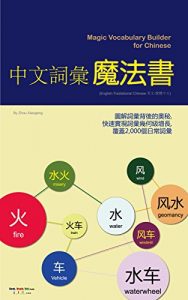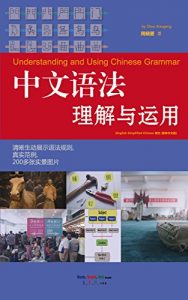For most learners of the Chinese language, two kinds of tools are essential for them: one is a dictionary, and the other is a grammar book. If we think of the learning process as building a house, a dictionary represents the utilities and features of the raw materials for construction, while a grammar book shows the principles and methods for how to build a house with the materials.
"Interesting," "practical," and "unique" are the right words for describing this grammar book. This book not only introduces the fundamental knowledge about the Chinese language but also, and more importantly, reveals the reasons behind the principles and rules, which helps learners to understand this language and apply the grammar rules well.
This grammar book actually gets learners out of the boring elements, such as excessive memorizing and drilling, for learning a new language, and it helps learners to create the correct the words and sentences similar to what they do in mathematical calculations. Only in this way can learners radically accelerate their learning process and get more fun from learning a new language.
"漢語難學"是很多海外學習者普遍的感受,尤其是那些與我們有著巨大文化差異的歐美學習者,這種反映更為突出。根據美國《時代週刊》一篇報導中的統計,對於美國學習者而言,達到漢語中級水準所需學習時間通常要比達到西班牙語中級水準所需的學習時間多出近三倍!
實際上,所謂"漢語難學",並非是因為漢語本身有多複雜,而是在於漢語的"不同"——漢語有著自身獨特的思維方式以及語言規則,而它與英語等語言之間的差別,宛如如同中醫與西醫的差別。
破解這個困境的根本在於:讓學習者真正理解漢語複雜表面之下的"簡單":我們需要讓學習者理解漢語自身的思維方式特點、理解語法規則與語言習慣的深層次的合理性。只有幫助學習者真正把握了漢語的"經絡",才能在根本上提高學習效率。
這無疑向國際漢語教育者和研究者提出了極富挑戰性的課題:首先,需要從全新的角度來發現漢語自身的思維特點與語用規則;其次,需要跳脫我們自身作為母語人群的話語體系,基於漢語學習者的角度,用更易懂、更易用,同時也更有趣生動的方式展現漢語。
這本書就是基於上面的目標編寫的。你會發現,它是本語法書,但不僅僅是本語法書。就理論體系、內容選擇以及編排方式而言,它更適合用於國際中文課堂教學。
Content 目錄
Chapter 1: Preparing to Start 必要的準備
Chapter 2 Secrets of Combination 組合的奧秘
Chapter 4 Multiple Combining Processes 多重組合過程
Chapter 5 Structures and Gradations 結構與層次
Chapter 6 Words in Special Types 特殊類型的詞
Chapter 7 Quantities, Times, and Places 數量、時間與位置
Chapter 8: About Sentences 關於句子
Chapter 9 To Make Comments and Descriptions 描述與評論
Chapter 10 To Describe Existence 描述存在
Chapter 11 To Describe Acts 描述動作
Chapter 12 To Raise Questions: Yes or No 疑問句:是或非
Chapter 13 To Raise Questions: Ask for Details 疑問句:詢問細節
Chapter 14 Past, Present, and Future 過去,現在和未來
Chapter 15 Start, End, and Span 起點、終點和跨度
Chapter 16 Connection and Integration 連接與整合
"Interesting," "practical," and "unique" are the right words for describing this grammar book. This book not only introduces the fundamental knowledge about the Chinese language but also, and more importantly, reveals the reasons behind the principles and rules, which helps learners to understand this language and apply the grammar rules well.
This grammar book actually gets learners out of the boring elements, such as excessive memorizing and drilling, for learning a new language, and it helps learners to create the correct the words and sentences similar to what they do in mathematical calculations. Only in this way can learners radically accelerate their learning process and get more fun from learning a new language.
"漢語難學"是很多海外學習者普遍的感受,尤其是那些與我們有著巨大文化差異的歐美學習者,這種反映更為突出。根據美國《時代週刊》一篇報導中的統計,對於美國學習者而言,達到漢語中級水準所需學習時間通常要比達到西班牙語中級水準所需的學習時間多出近三倍!
實際上,所謂"漢語難學",並非是因為漢語本身有多複雜,而是在於漢語的"不同"——漢語有著自身獨特的思維方式以及語言規則,而它與英語等語言之間的差別,宛如如同中醫與西醫的差別。
破解這個困境的根本在於:讓學習者真正理解漢語複雜表面之下的"簡單":我們需要讓學習者理解漢語自身的思維方式特點、理解語法規則與語言習慣的深層次的合理性。只有幫助學習者真正把握了漢語的"經絡",才能在根本上提高學習效率。
這無疑向國際漢語教育者和研究者提出了極富挑戰性的課題:首先,需要從全新的角度來發現漢語自身的思維特點與語用規則;其次,需要跳脫我們自身作為母語人群的話語體系,基於漢語學習者的角度,用更易懂、更易用,同時也更有趣生動的方式展現漢語。
這本書就是基於上面的目標編寫的。你會發現,它是本語法書,但不僅僅是本語法書。就理論體系、內容選擇以及編排方式而言,它更適合用於國際中文課堂教學。
Content 目錄
Chapter 1: Preparing to Start 必要的準備
Chapter 2 Secrets of Combination 組合的奧秘
Chapter 4 Multiple Combining Processes 多重組合過程
Chapter 5 Structures and Gradations 結構與層次
Chapter 6 Words in Special Types 特殊類型的詞
Chapter 7 Quantities, Times, and Places 數量、時間與位置
Chapter 8: About Sentences 關於句子
Chapter 9 To Make Comments and Descriptions 描述與評論
Chapter 10 To Describe Existence 描述存在
Chapter 11 To Describe Acts 描述動作
Chapter 12 To Raise Questions: Yes or No 疑問句:是或非
Chapter 13 To Raise Questions: Ask for Details 疑問句:詢問細節
Chapter 14 Past, Present, and Future 過去,現在和未來
Chapter 15 Start, End, and Span 起點、終點和跨度
Chapter 16 Connection and Integration 連接與整合








